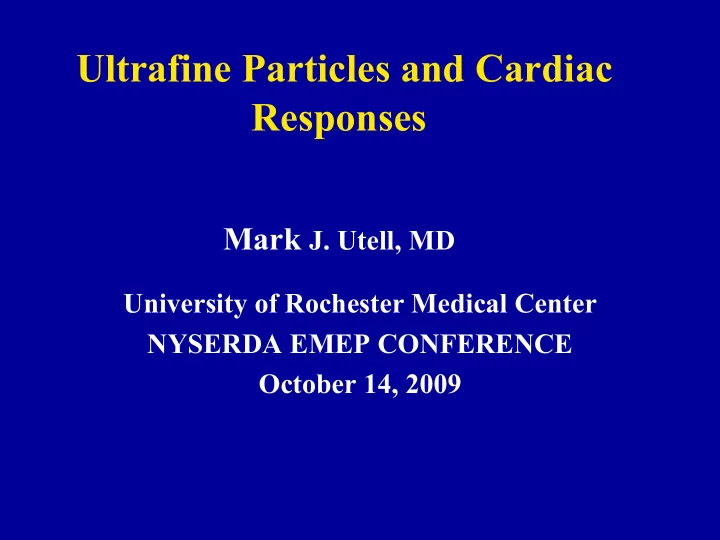

Ultrafine Particles and Cardiac Responses Mark J. Utell, MD University of Rochester Medical Center NYSERDA EMEP CONFERENCE October 14, 2009
Idealized Size Distribution of Particulate Matter (EPA, 2004)
EFFECTS AND FATE OF INHALED ULTRAFINE (NANO)PARTICLES (UFP) Sources Exposure Dose Response Epidemiologic Studies Indoors Concentration Deposition ng/m 3 - mg/m 3 ambient UFP frying nose 10 2 - >10 6 part./cm 3 susceptibles only? broiling tracheobronchial mortality/morbidity grilling alveolar electric motors ventilatory parameters Duration Clinical Studies minutes Disposition Outdoors lab. generated UFP hours within respiratory tract urban air ambient UFP days extrapulmonary organs internal combustion healthy/susceptibles continuous/peak disease state power plants (respiratory, cardiovascular) forest fires Location Physico-chemical airplane jets Animal Studies distance from source recreation (ski waxing) Properties lab. generated UFP ambient UFP organics Workplace compromised animal models metals metallurgy (fumes) (respiratory, cardiovascular, CNS) crystalline welding mechanisms amorphous polymer fumes surface area nanotechnology In vitro Studies solubility (water, lipid) (biomed. electronics) mechanisms nanotubes oxidative stress
Ultrafine Particles: Why the Concern From A Health Perspective?
Numbers and Surface Area of Particles of Unit Density of Different Sizes at a Mass Concentration of 10 µg/m 3 Particle Diameter Particle Number Particle Surface Area 1/cm 3 µm 2 /cm 3 µm 0.02 2,400,000 3016 0.1 19,100 600 0.5 153 120 1.0 19 60 2.5 1.2 24
Surface Molecules as Function of Particle Size 60% % Surface Molecules 50% 40% Ns/N Ns/N 30% 20% 10% 0% 1 10 100 1000 10000 Dp [nm] Diameter (nm) From Fissan, 2003
UFP Deposition and Retention During 2 h Exposure
Fractional Deposition of Inhaled Particles in the Human Respiratory Tract (ICRP Model, 1994; Nose-breathing) 1.0 % Regional Deposition Nasal, Pharyngeal, Laryngeal 0.8 0.6 0.4 0.2 0.0 0.0001 0.001 0.01 0.1 1 10 100 Diameter ( µ m) 1.0 % Regional Deposition 0.8 0.6 Tracheobronchial 0.4 0.2 0.0 0.0001 0.001 0.01 0.1 1 10 100 Diameter ( µ m) 1.0 % Regional Deposition 0.8 0.6 Alveolar 0.4 0.2 0.0 0.0001 0.001 0.01 0.1 1 10 100 Diameter ( µ m) Figure courtesy of J.Harkema
Background: Evidence for UFP Health Effects • Animal studies: increased lung inflammation and trans- location to blood and distant organs (Oberdorster et al.) • UFP concentrations high at roadside (Sioutas, et al.) and as a result of local sources (Jeong, et al.) • Traffic-related PM effects on mortality/morbidity (Kunzli et al.; Peters et al.) • UFP decreased peak expiratory flow rates in asthmatics (Peters et al.) • UFP caused ST-segment depression during exercise testing in CAD (Pekkanen et al.)
Objectives - NYSERDA Study: UFP and Cardiac Responses • Test over 10 weeks whether changes in community ambient ultrafine particle counts are associated with changes in cardiac rehabilitation patients’ : - Symptoms - Heart rate and blood pressure - Cardiac electrophysiology, autonomic nervous system control - Blood markers of inflammation, coagulation - Rate of cardiac rehabilitation
Study Design • 75 non-smoking patients with recent coronary artery disease exercise for 30 minutes in the cardiac rehabilitation center • Baseline questionnaire • Exercise twice weekly x 10 weeks • Treadmill , cycle, or rowing • Multiple Clinical Assessments each visit
Exposure Measures • Ultrafine particles in two community sites, hourly average • Ultrafine particles in cardiac rehab center, hourly average • Ozone, N0x, CO, sulfur dioxide, temperature from same site as ultrafines • Sub-ample: ultrafine particles for 48 hours indoors, subject homes • Sub-sample: ultrafine particles in vehicles driving to/from cardiac rehab center.
N SO 2 Source CO E W Source S CO and SO 2 Source SO 2 Source NYS DEC Site CRC Site CO, SO 2 and NOx Source 2 Miles Map of Rochester area showing measurement sites and major emissions in the study
Daily Morning Variability: Mean hourly patterns of the indoor particle number concentration in three size bins Cardiac Center
Time of Day Variability: (b) Outdoor (a) Indoor 2500 5000 2005 (a) 10-50 nm 2005 (a) 10-50 nm 4500 ) 2006 2006 ) -3 -3 2007 2007 2000 2008 2008 4000 3500 1500 3000 1000 2500 2000 500 1500 Particle numb Particle numb 0 1000 0 5 10 15 20 0 5 10 15 20 Time of the day Time of the day Mean daily patterns of particle number concentration in the 10- 50 nm size bin at Cardiac Center
Subject Recruitment to Date 75 subjects recruited and under study 68 have completed full protocol Age range : 36-80 years (mean = 60 yrs) Gender: 66% male Subjects live within 10 mile radius of a particle monitors Diagnoses: recent myocardial infarction 60%); unstable angina with coronary stents (35%)
Outcome Variables • Days with angina • Rated perceived exertion at maximal exercise • Heart Rate/BP pre, peak, post exercise • Blood counts, • Electrophysiology pre, C-reactive protein peak, post exercise fibrinogen, weekly (pre- (HRV, repolarization, exercise) etc)
Analysis Strategy • Biostatistics Group examining UFP number concentrations and outcome variables • Key Features of study design: - longitudinal measurement on each subject - highly susceptible group - indoor and outdoor continuous UFP
Cardiac Rehab Study of Ultrafine Particles Univ. of Rochester School of Medicine Clarkson University • Philip Hopke Karen Stulpin • Mark Frampton David Chalupa • G. Oberdorster John Kasumba • Wojciech Zareba • David Oakes Funding: EPRI, • Annette Peters EPA, NYSERDA • Bill Beckett
Recommend
More recommend